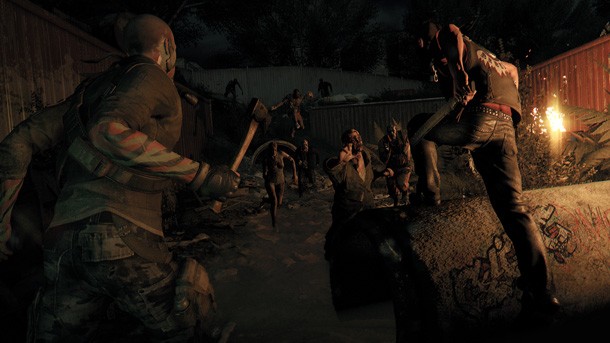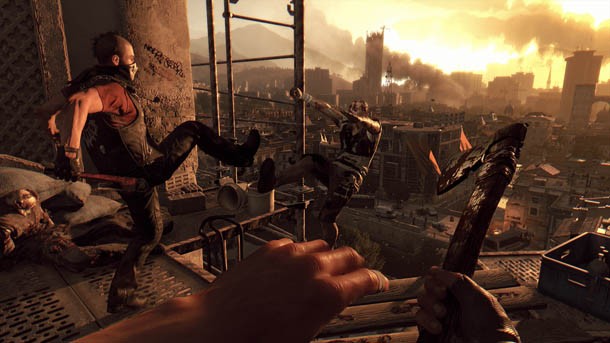Hands-On: The Ups And Downs Of Dying Light

Techland's latest take on the zombie apocalypse is finally here, and Dead Island fans have been eagerly waiting to see if the developer's newest open-world offering can improve upon the flaws of its predecessors. We've only just begun to sink our teeth into Dying Light's meaty campaign, so you'll have to wait a few more days for our official review. In the meantime, here's what I've enjoyed so far (and what I haven't), based on my five-or-so hours with the PS4 version.

A Beautiful Wasteland
Techland
ditched the last-gen versions of Dying Light because it felt the old
consoles weren't up to snuff, and the decision seems to have paid off. The city
of Harran looks great (in that hell-on-Earth-viral-outbreak kind of way),
zombies are appropriately grotesque, and the lighting system sells the dynamic
transition from day to night. Trees and buildings in the far-off distance can
be an eyesore, but you'll likely be too focused on the snarling corpse snapping
in your face to notice.
A Slow Start
Don't expect to jump right into the zombie-slaying mayhem
when you start up Dying Light. After an action-packed cutscene of you
parachuting into the undead-infested city, you're promptly ushered into an extended
series of tutorial missions in a zombie-free apartment building. These do a
good job of introducing you to the characters, gameplay mechanics, and RPG
systems of the game, but you'll be itching to get into the city by the time
your first real mission pops up.

Freerunning Through
The Apocalypse
When it came to navigating the lush, tropical locations of
Dead Island, survivors were scarcely more agile than their undead enemies. I
was skeptical that Techland could pull off Mirror's Edge-style parkour
mechanics, and while I'm still not completely sold, the traversal system has
worked well so far. You can run, jump, and slide your way around the
environment (and your enemies) without having to catch your breath every 10
seconds, and visual clues make it easy to tell what you can climb and where you
can safely fall (most of the time anyway). I've had my fair share of flubbed
jumps and climbing fails, but you still have a lot more freedom of movement
than in most first-person games, which is vital for a world where you spend more
time avoiding enemies than you do confronting them.
On A Mission
Harran offers players a great big sandbox teeming with
deadly brain-munchers. While exploring the city has been compelling, the
handful of campaign missions I've completed beyond the opening tutorial have
been of the errand-boy variety. Whether I'm arming traps, activating radio
towers, or retrieving medicine, all of the missions have entailed little more
than going to a location and pressing a button. I'm hoping missions will become
more involved as the game progresses, and offer some interesting twists on Dying
Light's underlying systems.

Cringe-Inducing Combat
Dead Island really sold its visceral, melee-focused combat,
and Dying Light only offers improvements to returning fans. Deadly blows are
now highlighted by slow-motion and X-ray effects, and physics play a larger
role in the action – dropkicking a shambling corpse into a wall of spikes is as
morbidly satisfying as you'd expect it to be. Techland has also introduced
several enemy types in the first few hours of play, which require different
strategies to take down (though my patented run-away-from-everything-that-moves
technique has proven universally successful so far).
Coming Up Next: Find out about weapon durability, the story, and things that go bump in the night...

Durability Is Back
I've never been a fan of weapon durability, and Dying Light
hasn't changed my mind on the mechanic. Like in Dead Island, weapons will break
after a certain number of hits. You can repair your items using scrap metal,
which can be looted from the environment or gained by breaking down other
unwanted weapons. However, each weapon can only be repaired a certain number of
times, after which you're forced to move on to your next tool of destruction.
So far, I've come across plenty of new, more powerful weapons, so durability
hasn't been much of an issue, but it is still a bummer to know that every hit I
land is bringing me one step closer to parting with a favorite weapon.
Plenty of Depth
In addition to a big open world, Dead Island offered plenty
of depth in its weapons, crafting, and leveling systems. This is true of Dying
Light as well. Players will level up in three distinct fields – survival,
agility, and combat – each of which features its own sprawling skill tree. Most
of the skills I've unlocked so far have provided meaningful additions to my repertoire,
as opposed to simple stat increases. The crafting system is also substantial,
and you can create new items on the fly (no more heading all the way back to a
safe house to use a crafting table).

Menu Mayhem
Unfortunately, all of Dying Light's depth comes at a price. While
not as bad as Dead Island, the game's inventory and crafting menus are still more
confusing than they should be, and provide a lot of information without an easy
way to parse it all. Be prepared to spend a lot of time in the menus while you
learn the ropes, and even then you'll be constantly flipping back and forth
between menus as you compare weapons, craft items, and manage your inventory.
Night Terrors
Techland said that you wouldn't want to get caught outside
when the sun sets in Dying Light, and they weren't lying – nighttime is
terrifying. Regular zombies transform into split-mouthed Night Hunters that are
just as fast and agile as you are, and they'll chase you relentlessly, calling
attention to every other hideous beast lurking nearby. My after-hours
experiences in Dying Light have consisted of frantic dashes through the city
and not breathing until I've reached the nearest safe house. Basically, daytime is to nighttime in Dying Light as Night of
the Living Dead is to 28 Days Later.
If you understand and are excited by that analogy, you're in for a real treat
when the sun goes down in Dying Light.

Story Time
Dying Light's story is still the biggest unknown for me. The
dialogue has made me wince on more than one occasion, as has some of the voice
acting (prepare yourself for some over-the-top accents). That said, there are
some standout characters that transcend the typical zombie-apocalypse survivor tropes.
The story premise is also more interesting than virtually every other
zombie-related video game, but I'm still not sure if it's going anywhere
interesting. The only way to find out is to keep playing, but so far I'm
intrigued.
To see Dying Light in action, check out our recent Test Chamber.

Get the Game Informer Print Edition!
Explore your favorite games in premium print format, delivered to your door.
- 10 issues per year
- Only $4.80 per issue
- Full digital magazine archive access
- Since 1991









